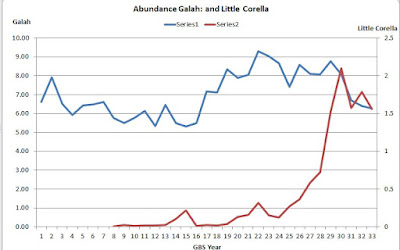This species has been recorded in 10 of the 105 months for which I have records. However, 6 of those months have been September 2014 - January 2015 and now December 2015, which gives the impetus to the post.
The species is more commonly found in the dry country West of the Great Dividing Range. This image shows them cleaning up split grain at the Deniliquin rice mill. (and I
For the Canberra region the situation is shown in the following chart of reporting rate from the COG Bird Info page for the species.
It was - and I think still is - the view that the initial sightings were of birds that had escaped from the Mugga Lane Zoo. However the birds are now so numerous and widespread that they have been recently joined by wild birds that have somehow got the message that there is good food and many tree hollows for nesting in this direction.
The distribution in the area is indicated in this map.
- Queanbeyan where the Queanbeyan River goes under Monaro St; or
- Bungendore, both the holding paddocks on Trucking Yard Lane or Mick Sherd Oval.
An interesting comparison exists with Galahs. While these are now very common birds in this area, going back to the 1950s they were very unusual here.This is illustrated by the Reporting Rate Chart from COG (I suspect the very low values prior to 1987 reflect reporting bias away from such common birds - they were well established by then).
Using data from the COG Garden Bird Survey compares the pattern for the two species. Note that the two lines are at different scales, as indicated.
This led one analyst to ask whether it was likely that Corellas would overtake Galahs in the area. One way of addressing such a question is to use an EXCEL trend function and project the trendlines forward. Doing this as a mechanistic exercise suggests that the species will cross over in the nearish future.
Although the values of the correlation coefficient for Galah suggest that the trend line is quite good, I am distrustful of such a dramatic drop off as indicated by the projected trend line.
For this to happen there would have to be some dramatic event within the local Galah population or some element of the local environment on which they rely (perhaps conversion of all the grassland, which they use as a source of food, into McMansion Slums would do it? Should that be the case I would expect the Little Corellas to join them in going down the gurgler.
The key action here seems to be "Wait and See". If the Galahs have regained numbers in 2014-15 then a different picture may emerge.







No comments:
Post a Comment
I am very happy to receive constructive comments. However anything I deem offensive will not be published.